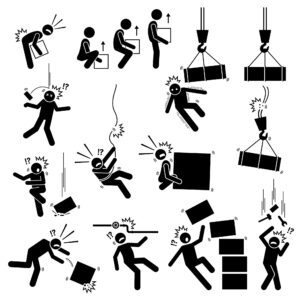This is our guide on whether you could claim if there was no manual handling risk assessment in the workplace and this caused you to be injured.
In order to make an accident at work claim, you must be able to prove that your injuries were caused due to your employer’s negligence. We will explain the criteria that you must satisfy to make a personal injury claim. In addition, we will discuss the legislation in place to protect employees at work when manually handling heavy loads.
This guide will also offer some examples of evidence that can be used to support different aspects of your claim. We will also look at the different kinds of damages that could be awarded.
If you are interested in making a manual handling claim for an accident that occurred after a lack of risk assessments, please continue reading. You can also contact us for free; after a free consultation, our advisors may connect you to a solicitor from our panel. Contact us by:
Contact Details
- Speak to an advisor over the phone; call us on 0161 696 9685.
- Contact us online.
- Message us using our live chat feature below.
Select A Section
- Can I Claim If There Was No Manual Handling Risk Assessment In The Workplace?
- How Do I Show My Employer Was At Fault?
- What Manual Handling Accidents At Work Could I Claim For?
- Estimating Settlements In Workplace Manual Handling Accident Claims
- How Do No Win No Fee Accident Claims Work?
- Find Out More About Manual Handling Accidents And Injuries
Can I Claim If There Was No Manual Handling Risk Assessment In The Workplace?
You may be eligible to claim if you were injured in an accident at work because there was no manual handling risk assessment in the workplace. This involves proving the following:
- Firstly, you were owed a duty of care.
- Secondly, there was a breach of duty.
- Thirdly, this breach caused your injuries.
Employers have a duty of care placed on them by The Health and Safety at Work etc. Act 1974 (HASAWA); this means that they must take reasonable and practicable steps to maintain a safe workplace and prevent injuries to their employees.
One of the steps that an employer is expected to carry out is carrying out risk assessments. Therefore, if no risk assessment was done, and you were injured as a result, you may be able to claim.
What Are Manual Handling Risk Assessments?
As outlined in the Management of Health and Safety at Work Regulations 1999, employers need to carry out risk assessments before a manual handling task is undertaken. If the task can be avoided altogether, then this should be done.
Employers can follow the Health and Safety Executive (HSE) managing health and safety approach, ‘Plan, Do, Check, Act’, to reduce the risk of injury when carrying out this kind of task:
- Plan what you need.
- Do the right things to install your plan.
- Check your control measures.
- Act if your measures aren’t working.
If you’re unsure whether negligence was the cause of your injury, why not speak with a member of our team today? They could offer you a free, no-obligation assessment of your claim. However, if your case is valid and you’d like to proceed, they could connect you with a No Win No Fee lawyer.
How Do I Show My Employer Was At Fault?
Evidence is an important component in a successful claim and can be used to prove liability. It can also be used to highlight the extent of the harm you were caused, illustrate any psychological injury and prove any financial losses.
Here are some examples of evidence you could collect for your claim and how it could be utilised:
- CCTV footage of the accident – can be used to show how exactly the accident happened.
- A diary of your recovery – an account of your treatment and symptoms can illustrate any psychological injury and physical symptoms.
- Records of expenses – receipts and payslips may be used to show financial losses.
- Contact details of eyewitnesses – eyewitnesses can give an account of the accident at a later date.
- Photographs – these can be used to highlight the extent of the damage.
- Reporting an injury in the accident book – provide a contemporaneous account of how the incident occurred.
One of the services our panel of solicitors provide is helping clients collect evidence for their cases. Contact our friendly advisors today if you want some help collecting evidence. They will be happy to help and may connect you with a solicitor from our panel.
What Manual Handling Accidents At Work Could I Claim For?
Manual handling injuries usually consist of musculoskeletal injuries. According to the HSE workplace injury statistics, of all employer-reported musculoskeletal injuries in 2021/22, back injuries comprised 42%, lower limbs 21% and upper limbs or neck 37%.
Here are some examples of injuries that could be caused, but aren’t limited to, manual handling injuries:
- Lower back injuries from heavy lifting may cause damage to the lumbar spine.
- Leg injuries may be due to a lack of manual handling training which means you fall backwards when you lift the load, and it lands on your torso and legs.
- Shoulder injuries may be due to an unnatural posture while handling the load.
- Neck injuries due to a twisting motion whilst handling the load.
Estimating Settlements In Workplace Manual Handling Accident Claims
In the event of a successful claim, your settlement may be made up of up to two heads. Taking into account the pain and suffering caused by your injuries, general damages is the first of these heads. It will always be awarded in successful personal injury claims.
Below is a table of compensation brackets for example injuries taken from the Judicial College Guidelines (JCG). This is a publication that solicitors use to help them value general damages.
Compensation Table
Injury Value Notes
(i) Severe Back Injuries £91,090 to £160,980 Spinal cord and nerve root damage leading to a series of serious consequences.
(ii) Neck Injuries £65,740 to £130,930 Substantial loss of movement in the neck combined with loss of function in one or more limbs.
(i) Severe Knee Injuries £69,730 to £96,210 Disruption of the joint, ligamentous damage and lengthy treatment with considerable pain.
(ii) Severe Injuries to Hip/Pelvis £61,910 to £78,400 Traumatic myositis ossificans where the ectopic bone forms around the hip.
Serious Hand Injuries £29,000 to £61,910 Hand use reduced to 50% capacity.
(iii) Serious Leg Injuries £39,200 to £54,830 Injuries resulting in instability, lengthy treatment and period of non-weight bearing.
Severe Ankle Injuries £31,310 to £50,060 Extensive period of treatment or where pins and plates have been inserted.
Less Severe Elbow Injuries £15,650 to £32,010 Impaired function but not involving major surgery or permanent disability.
Wrist Injuries (c) £12,590 to £24,500 Some permanent disability, such as, pain and stiffness.
Fracture of Clavicle £5,150 to £12,240 Award will depend on extent of fracture and level of disability.
Please note that the figures in this table are not guaranteed sums for successful claims; they are only guidelines. Each claim is unique and will attract different awards depending on the facts and circumstances of the case.
Could You be Awarded Special Damages?
The other potential head of claim is special damages; this accounts for the past and future financial losses incurred from the injury. Here are some examples of costs that special damages you can claim for:
- Loss of earnings.
- Travel expenses.
- Medical costs.
- Renovations to home and vehicle.
Once again, you should provide evidence such as payslips and receipts to support this head of claim.
How Do No Win No Fee Accident Claims Work?
You could make a personal injury claim with a No Win No Fee solicitor. They may offer to work with you under a Conditional Fee Agreement (CFA). This means there will be no upfront costs, and you will not be charged any ongoing bills for your solicitor’s services.
Usually, you will only be charged if your claim is successful. In the event of a successful claim, your solicitor will deduct a small success fee. This will be made up of a legally-capped percentage of your compensation.
You can begin your claim today by contacting one of our advisors for free. After your consultation, they may connect you to a manual handling solicitor from our panel with experience dealing in similar claims. Contact us by:
Contact Details
- Speak to an advisor over the phone; call us on 0161 696 9685.
- Contact us online.
- Message us using our live chat feature below.
Find Out More About Manual Handling Accidents And Injuries
You can find more links that may be relevant to claims where there was no manual handling risk assessment in the workplace.
Internal links:
- Our guide on forklift truck accident claims.
- Information on conveyor belt claims.
- Find out how to claim a back injury from lifting.
External links:
- GOV.UK – Request CCTV footage of yourself.
- NHS – Get your medical records.
- HSE – Accident book.
Writer MWH
Publisher FS


